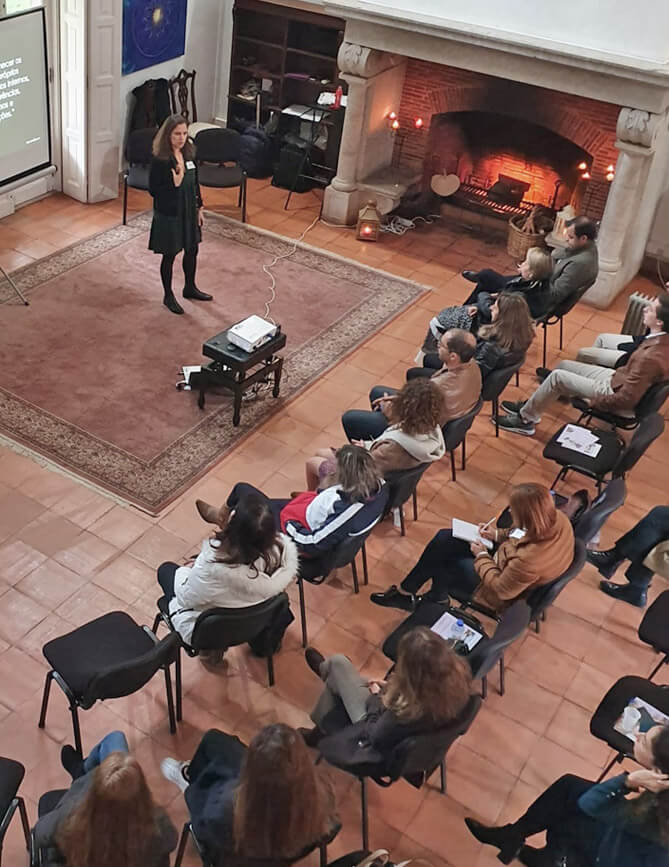A complete meditation practice trains five elements: attention, intention, attitude, action, and impact. It helps to understand attention, intention, and attitude (the first three) as the upper triangle which easily represents the mind, the dedicated practice, or the being. On the other hand, attitude, action, and impact (the last three) conform the lower triangle and represent the body, the integrated practice, or the doing. Attitude connects both triangles. This drawing easily illustrates them. If you want to know better and deeper, please refer to these previous publications: “Training in attention, intention, and attitude” and “Training in attitude, action, and impact (part 1) and (part 2) ”.
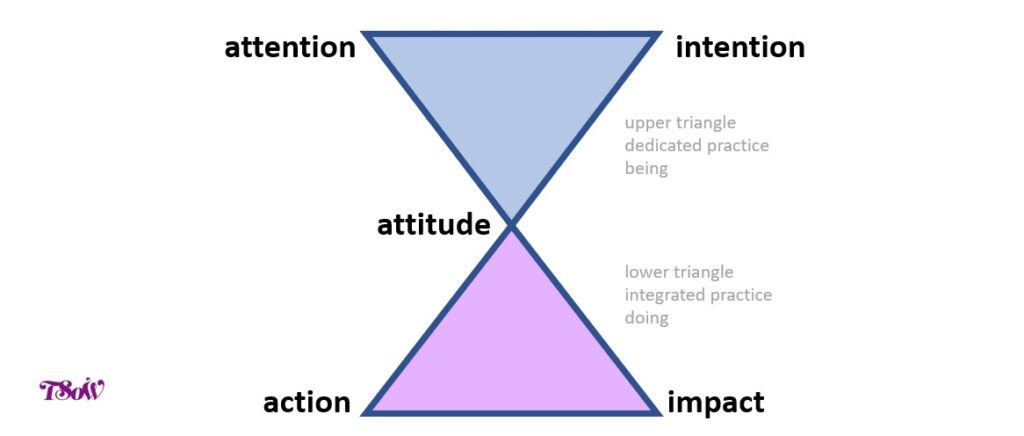
I have been in search of a name for this drawing, a drawing which helps me to understand my practice and to share what it means to meditate during workshops and programs. The first name that I felt adequate is “the skeleton of consciousness”. Also, I felt that “the skeleton of energy” makes the work. However, at this moment, I choose to name it “the skeleton of the self” even if it is too narrow to convey everything behind.
The skeleton of the self is a conceptual framework that helps to navigate with some comfort around the two important questions of life: “who am I?” and “what am I here for?”. These two questions can also have different wordings, like the one used by Otto Scharmer in his Theory-U: “what is my Self?” and “what is my Work?”.
The reason-why behind my choice of “the skeleton of the self” is because it facilitates, by definition, the very first level of understanding: it is a skeleton, something hidden but omnipresent in all beings which is key to explain any experience or movement. Also, because it moves “the self”.
These two drawings will introduce what I mean at this moment by “the self”.
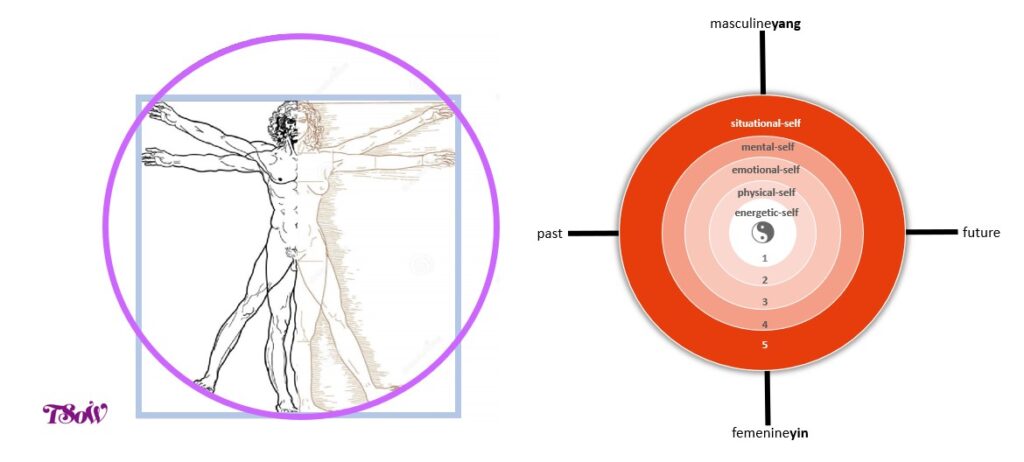
Never mind if you have a male experience, a female experience, or something in between (left: “the form outside”), you will be able to identify these five experiences within you (right: “the form inside”):
- the situational experience, or the situational self, which illustrates what you experience in a situation made of time, space, objects, and relationships.
- the mental experience, or the mental self, which illustrates what you are thinking at any situation.
- the emotional experience, or the emotional self, which illustrates what your emotions are at any situation and with any thinking.
- the physical experience, or the physical self, which illustrates what your physical body feels at any situation, with any thinking, and with any emotion.
- the energetic experience, or the energetic self, which illustrates what is your energy field at any situation, with any thinking, with any emotion, and with your physical body.
These five elements of the self-experience are organized around two axes:
- the horizontal axis refers to the time: “the past” is in the left; “the future” is in the right. Of course, as the only real thing that we can experience is “the present moment”, I write “the past” or “the future” meaning what are those experiences about “the past” or about “the future” which are consciously or unconsciously included in my “present” moment.
- the vertical axis refers to the energy in life: “the masculine yang” is up; “the feminine yin” is down. These by themselves could be confusing, even conflicting, but I would like to ask for some faith here. So please, accept them in the narrowest understanding, where “masculine yang” refers to how consciously or unconsciously “closed” I am regarding the current experience, and “feminine yin” refers to how consciously or unconsciously “opened” I am regarding the current experience.
- the crossing point is “the present” where “energies meet and get in balance”.
This third drawing fully integrates these concepts and illustrates what I mean when I think about “the self.” I feel that “naming” can be slippery, but it is key to better communicate among ourselves. However, sometimes, I also referred to “the self” in a more descriptive way, like “the 5 levels of the self”, “the 5 experiences of the self” or “the form of the self”.
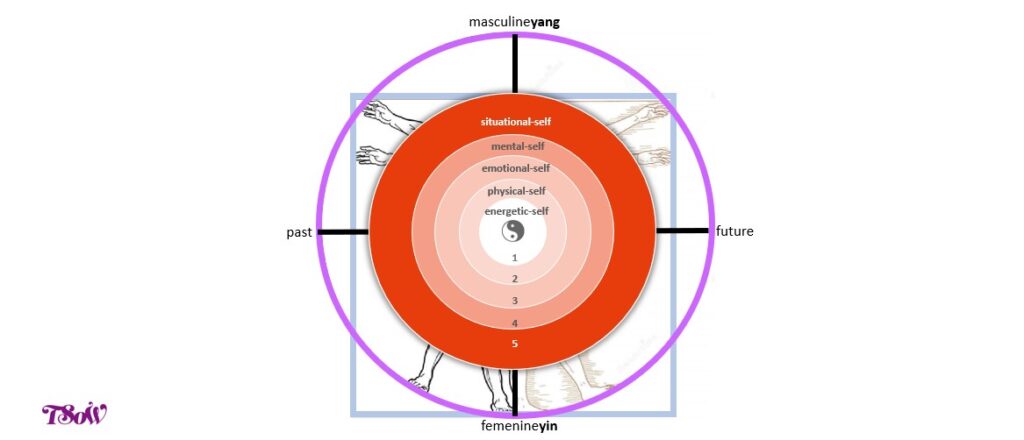
Once we have a mutual understanding of the self, we come back and recall “the skeleton of the self.” Let me remind for us the definition as “that something hidden but omnipresent in all (human) beings which is key to explain any experience or movement.” Additionally, let us remember that it has also five elements: attention, intention, attitude, action, and impact. Just in case, it is a coincidence that in both cases we are talking about five. Please, note that there is no matching at all and that this is just a beautiful coincidence.
At this point, it is especially important to notice that it is attention, and only the movement of attention, what will help to be aware of the five levels of the self. In fact, the three basic mindfulness practices (focus attention, open awareness, and body scan) share this common goal and train us so we can voluntarily:
- move our attention towards surroundings (which is our situational experience);
- move our attention towards thoughts (which is our mental experience);
- move our attention towards emotions (which is our emotional experience);
- move our attention towards respiration and physical sensations (which is our physical experience);
Of course, it is also important to notice that focus attention is about “closing” or narrowing attention towards something (like breathing) and open awareness is about “opening” or broadening attention to everything (like whatever comes to your mind). These match with the training of the two basic manifestations of our energetic experience: “to close” and “to open.”
Additionally, more complete mindfulness practices guide us to go back and reflect over past experiences, or to move forward and envision future scenarios.
On the other hand, whatever of the basic movements in the skeleton do manifest in a push and/or pull movement of several of “the 5 levels of the self”. These are very simple examples:
- directing your attention moves mental-self and physical-self;
- raising an intention moves mental-self and emotional-self;
- embodying an attitude moves emotional-self and energetic-self;
- performing an action moves physical-self and energetic-self;
- monitoring an impact moves mental-self and energetic-self.
So, this next drawing becomes “the map of the self” inside (built as “the 5 levels of the self” plus “the skeleton of the self”) which gives full meaning and order to concepts and practices for “self-awareness”, “self-knowledge”, and “self-management”.
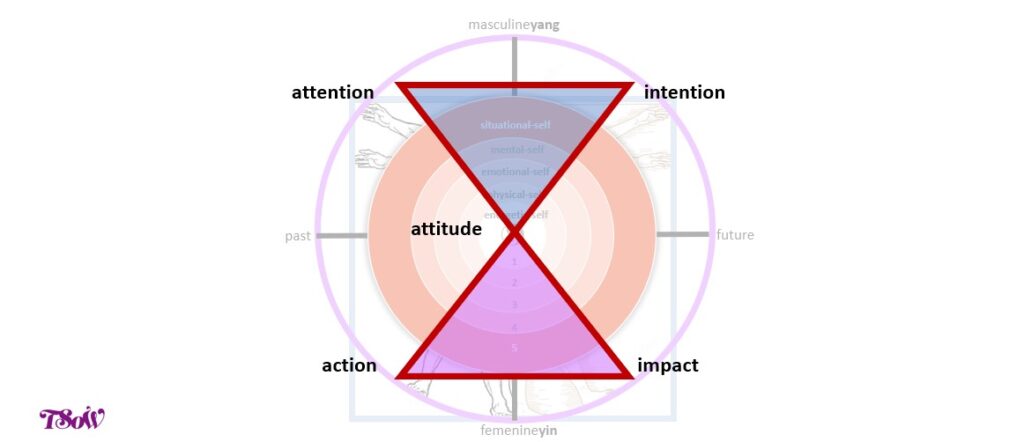
I will complete this post by adding a point of view about the very basic movement that we want to create and experience when we start practicing any form of meditation.
The assumption that defines the starting point is that we are so distracted, so unaware of the self, that we behave in automatic pilot. We react to whatever happens around us and inside us without choice, compulsively, without much control of the impact that we are creating in ourselves (in the form of suffering) and in the way we relate with others (in the form of conflict).
Then, by repeated practice, which I like to write as the 4Ps of meditation (“practicing, practicing, and practicing with patience”), we are able to overcome distractions and manage our attention “to be aware of the wholeness of the self in the present moment”. This first movement is depicted in this last drawing.
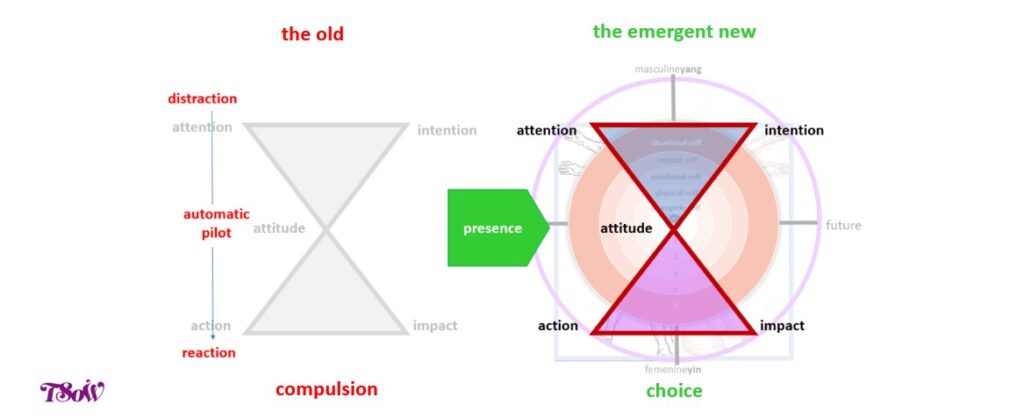
When we talk about mindfulness, the key tool is “attention”, so it is a “top-down approach” to build awareness of the self. In other forms of meditation, like yoga or conscious sexuality, the key tool could be better framed as “action” (like body positions or body massage), so these practices follow a “bottom-up approach.” Of course, any complete meditation practice will embrace and train all the 5 elements of the skeleton of the self even when the starting point is different.
Before we close this analytic reflection, it is particularly important to recognize that everything we have said about the self should not be understood at all as an absolute truth. On the contrary, everything I have said about the self is just a small perspective of an infinite truth. No thought, no words and no drawing could ever embrace the infinite. Reality is a unified wholeness. The self is a unified wholeness.
But we only have thoughts, and words, and drawings to communicate among us. And thoughts, words, drawings do fragment reality. Yes, I know. This maybe brings false perceptions about the fundamental truth of unified wholeness, like any belief that it can be splitted and separated, and that each part has autonomy and can be treated individually.
However, I deeply feel that this simple view of what we are (as human beings) is helping me and others in the integration and evolution of our meditation practice. I also feel that when it has seeded inside deep enough, it helps in many ways to walk the path of becoming a better human being and contributing to a better, more beautiful world.
So, I hope and wish that all these also help you and others.

